Campus News
Engineering opportunities
Senior engineering students create design projects to address real-world problems—some with sponsorships from high-profile companies.


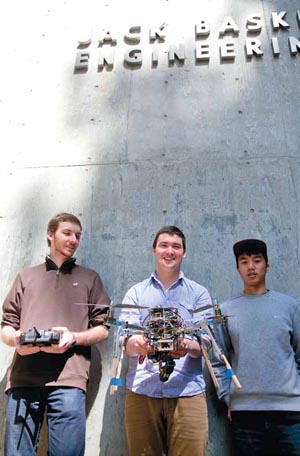
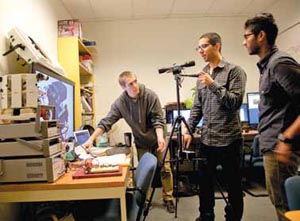

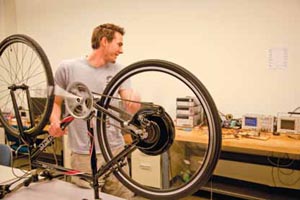
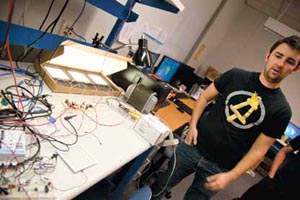
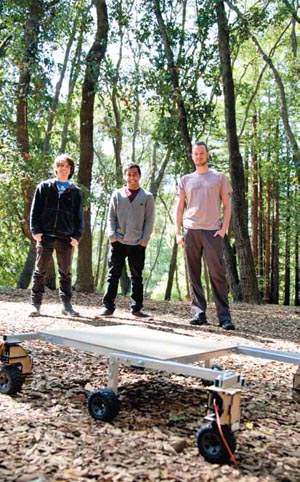
Imagine a robot that travels on the ceiling and helps you out around the house. Try to picture an autonomous, mechanized lifeguard that waits in the water, kicking into high gear when someone starts drowning.
These may sound like props in the latest J. J. Abrams movie, but engineering students at UC Santa Cruz have turned their collaborations with industry professionals into essential projects that address real-world concerns ranging from climate change and public safety to the secrets of extraterrestrial soil.
High-profile Silicon Valley companies are sponsoring 11 senior projects this year in the hopes of providing students with immersive “real world” industry experience while giving self-motivated Banana Slugs a toehold in the highly competitive tech world.
Industry leaders including Google, Netflix, Xilinx, and Oracle meet with students each week to check on their progress and offer tools to help them succeed.
For engineering seniors, the design project is a transition from being a Banana Slug to a contributing member of a team in a career in industry or research.
Carol Owens (Crown College) is team leader on a project sponsored by Google to build a mobile environmental sensing system that plots field-recorded data on Google Maps.
It’s her first time working in a group, and she’s learning about the challenges of reaching a consensus. She says she was drawn to the project because of its potential to help in the real world.
“It has a positive impact on the environment by helping environmental scientists gather data and raising public awareness about pollutants and greenhouse gases,” said Owens.
Finding the right project for students involves a little “matchmaking,” said Patrick Mantey, who directs UCSC’s Center for Information Technology and Research in the Interest of Society (CITRIS) and is associate dean of industry programs and Baskin Professor of Computer Engineering. Some students decide to delve into venture capitalism and pursue challenges that are not funded by corporate sponsors.
A team of six seniors fronted $3,000 of their own money to enter the NASA Centennial Challenge, which helps NASA advance its use of technology through the use of prize competitions.
Geoffrey Budd (College Ten) and his colleagues are competing with 13 other teams from around the world to build a robot that can locate and retrieve extraterrestrial samples.
“If we are successful, not only will we have learned a great deal about autonomous robot navigation and construction, but we will also have brought a significant amount of attention to UCSC’s new robotics engineering major,” Budd said.
Budd and the rest of the team were notified in March that the cost of materials for the project will be funded by the UC Santa Cruz Foundation.
Students who are building a robotic lifeguard are also willing to fund their own project.
The lifeguard robot the team is building will be able to travel faster than a human lifeguard’s average swim speed.
“Coming from a beach town, we realized the need for safety,” said team leader Darrel Deo (Crown College). “Our lifeguard will not suffer from fatigue.”
Ethan Papp (Crown College, ’12) led a team last year that built a prototype for a glass microphone. He’s back this year as a teaching assistant for the corporate senior design courses. He said he learned about professionalism and high expectations during last year’s project.
“We were expected to produce nothing short of excellent quality work because it would be showcased and shared with a representative from Corning Incorporated, which was sponsoring our project,” he said.
Last year’s corporate sponsors hired many of last year’s crew of engineering students. The high-profile companies know that UCSC engineering students are learning about the values of hard work and collaboration, said Mantey.
“The partnerships with industry, and the participation of the industry engineers in guiding their projects, give our students the opportunity to understand how to work in the real world,” said Mantey.
Amy Ettinger is a freelance writer based in Santa Cruz.
In good company
2013 senior engineering design corporate sponsors:
• Applied Materials • Dell KACE • eBay • Echelon • Google • Netflix • Oracle • Raytheon • Xilinx • Yaskawa